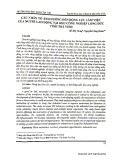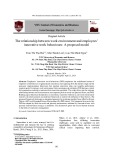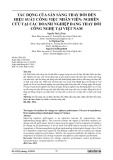
http://www.iaeme.com/IJM/index.asp 37 editor@iaeme.com
International Journal of Management (IJM)
Volume 9, Issue 2, March–April 2018, pp. 37–42, Article ID: IJM_09_02_004
Available online at
http://www.iaeme.com/ijm/issues.asp?JType=IJM&VType=9&IType=2
Journal Impact Factor (2016): 8.1920 (Calculated by GISI) www.jifactor.com
ISSN Print: 0976-6502 and ISSN Online: 0976-6510
© IAEME Publication
EMPLOYEE ENGAGEMENT FOR THE
STRESSED EMPLOYEE
Monika Bharti
PhD Scholar, School of Business, Galgotias University,
Greater Noida, Uttar Pradesh, India
Dr. Anamika Pandey
Associate Professor, School of Business, Galgotias University,
Greater Noida, Uttar Pradesh, India
ABSTRACT
Stress is a growing concern for employees in organizations today. We can define
stress as a lively circumstance where people have to face constraints or loss of
something they desire and for which the consequences are both unpredictable and
crucial. A stressed employee is a common sight in todays companies.
Kevin Kruse from Forbes.com says the definition of employee engagement is,
“Employee engagement is the emotional commitment the employee has to the
organization and its goals.” It is actually the level of enthusiasm and dedication an
employee feels for his organization. In this article we study to find out ways to manage
an employees tress using employee engagement and how important employee
engagement is for every organization today.
Key words: Employee engagement, Stress management, HRM, Stress, Burnout,
Organizational performance.
Cite this Article: Monika Bharti and Dr. Anamika Pandey, Employee Engagement for
the Stressed Employee. International Journal of Management, 9 (2), 2018, pp. 37–42.
http://www.iaeme.com/IJM/issues.asp?JType=IJM&VType=9&IType=2
1. INTRODUCTION
1.1. Employee Engagement
Employee engagement is a vast construct that touches almost every part of human resource
management that we know and study. Engagement at work was conceptualized by Kahn
(1990), as the harnessing of organizational members‘ selves to their work roles. In
engagement people employ and express themselves physically, cognitively and emotionally
during role performances. Employee engagement is a vast construct that touches almost all
parts of human resource management facets we know hitherto. If every part of human
resources is not addressed in appropriate manner, employees fail to fully engage themselves
in their job in the response to such kind of mismanagement. The construct employee

Monika Bharti and Dr. Anamika Pandey
http://www.iaeme.com/IJM/index.asp 38 editor@iaeme.com
engagement is built on the foundation of earlier concepts like job satisfaction, employee
commitment and Organizational citizenship behaviour. Though it is related to and
encompasses these concepts, employee engagement is broader in scope. Employee
engagement is stronger predictor of positive organizational performance clearly showing the
two-way relationship between employer and employee compared to the three earlier
constructs: job satisfaction, employee commitment and organizational citizenship behaviour.
Engaged employees are emotionally attached to their organization and highly involved in
their job with a great enthusiasm for the success of their employer, going extra mile beyond
the employment contractual agreement.
The last two decades has seen the phase of transition from ‗satisfied‘ employees to
‗committed‘ employees (Avery et al, 2007; Buckingham and Coffman, 1999) who are not
predisposed to attrition, rather immersed in the goal and success of their organization and
often serve as the force behind the success of the organization. As we see that most of the
employees today are suffering from stress related issues like health issues, low productivity,
lack of morale, etc., it is indeed a need for organizations to manage these stressed employees
and keep them happy and satisfied in order to keep up the productivity level high. Thus,
employee engagement comes in handy for managing a stressed employee. The more
engagement an employee has with his organization, the more effort he puts forth and the more
loyal he feel towards his company and work. Employee engagement also involves the nature
of the job itself - if the employee feels mentally stimulated; the trust and communication
between employees and management; ability of an employee to see how their own work
contributes to the overall company performance; the opportunity of growth within the
organization; and the level of pride an employee has about working or being associated with
the company.
1.2. Employee Stress
While some workplace stress is normal, it can still interfere with the productivity and
performance of the employee, not to mention affecting the employee’s relationships and
personal life. Stress isn‘t always bad. A little bit of stress can help you stay focused,
energetic, and able to meet new challenges in the workplace. It‘s what keeps you on your toes
during a presentation or alert to prevent accidents or costly mistakes. But in today‘s hectic
world, the workplace too often seems like an emotional roller coaster. Long hours, tight
deadlines, and ever-increasing demands can leave you feeling worried, drained, and
overwhelmed. And when stress exceeds your ability to cope, it stops being helpful and starts
causing damage to your mind and body—as well as to your job satisfaction.
The signs of stress for an employee at workplace can be physical, psychological or
behavioral.
Physical symptoms include:
Fatigue
Muscular tension
Headaches
Heart palpitations
Sleep difficulties such as insomnia
Dermatological disorders
Raised BP

Employee Engagement for the Stressed Employee
http://www.iaeme.com/IJM/index.asp 39 editor@iaeme.com
Psychological symptoms include:
Depression
Anxiety
Discouragement
Irritability
Pessimism
Reduced concentration
Behavioural symptoms include:
An increase in sick days or absenteeism
Aggression
Diminished creativity and initiative
A drop in work performance
Problems with interpersonal relationships
Mood swings and irritability
Lower tolerance of frustration and impatience
Disinterest
Isolation.
It seems clear that if we try, we can utilize employee engagement to reduce the stress
of employees and benefit both the employees well being as well as the organizations.
2. REVIEW OF LITERATURE
M. Kaliannan, S. N. Adjovu (2015) studied effective employee engagement ways and
organizational success. The researchers found out the core engagement strategies as: work
environment, HRM practices, employee-supervisor relationships, job satisfaction and
organizational culture which related to effective organizational success. Their data analysis
revealed that work environment was the least effective engagement strategy.
S. Markos, M. S. Sridevi (2010) studied the evolution of employee engagement through the
ages and how it is a key to improving performance of the employee and in turn the
organization. They discussed effective employee engagement strategies for managers and
indicated that employee engagement is closely linked with organizational performance
outcomes. Ten points or strategies called ‗the ten tablets‖ were suggested to keep employees
engaged. For managers, work of employee engagement starts at day one through effective
recruitment and orientation program, the work of employee engagement begins from the top
as it is unthinkable to have engaged people in the organizations where there are no engaged
leadership.
S. Devi (2017) researched the private sector banks for the impact of employee engagement on
organizational performance. She took 150 respondants for her study and the result were in
positive direction and fulfilled the research aims. It revealed a positive relationship between
employee engagement and organizational performance. It was observed that organizations‘
with higher levels of employee engagement outperform their competitors in terms of
profitability.
A. Siddhanta, D. Roy (2010) belonging from the corporate world themselves studied
employee engagement for the 21st century workforce. After extensive surveys, reviews and
study, it was indicated that high levels of employee engagement will lead to improved
employee commitment and involvement towards job and thus creating a motivated workforce.

Monika Bharti and Dr. Anamika Pandey
http://www.iaeme.com/IJM/index.asp 40 editor@iaeme.com
Engaged employees demonstrate three general characteristics: (i) Say – They consistently
speak positively about the organization to colleagues, customers, family & friends. (ii) Stay –
They have strong desire to be with the organization even if they get job offers outside. (iii)
Strive – They put in extra time, effort and initiative to contribute to business performance.
S. Agarwal (2016) used the survey method and conceptual model to test with a sample of 254
employees from diverse cultures as well as age to find factors influencing employee
engagement. It was found that employee from various age groups and cultures had different
likings and expectations from the organizations. The finding suggests that there is
considerable scope for improvement of some of the policies and practices in the sphere of
human resource management.
3. OBJECTIVE OF THIS STUDY
To study how employee engagement can help manage the stress of employees and how
beneficial employee engagement is in todays organizations.
4. METHODOLOGY
This study is mainly based on collection of secondary data. The data has been collected form
various sources of publications like journals, magazines, research articles and published
books.
4.1. Employee Engagement strategies
Business now a days is striving to increase performance. It has been observed that a satisfied
and engaged employee is directly proportional to increased performance. Thanks to
technology, nowadays business companies are making use of advanced techniques of
operation. As sophistication of technologies continues to evolve, they pose more challenges
for managers because organizations will have to need more number of employees with
increased technical and professional skills. These knowledge workers can not be managed
with old styles of totalitarian management. They expect operational autonomy, job
satisfaction and status. It is because of these facts that attention of managers is shifting
towards employees‘ side of organizations. From last quarter of twentieth century onwards,
concepts like employee commitment and Organizational Citizenship Behaviour (OCB) started
to appear on the ground that efficiency and productivity lie within the employees‘ ability and
commitment. Managers‘ eye is on how to keep employees engaged in their job. Employers
now realize that by focusing on employee engagement, they can create more efficient and
productive workforce.
In order for the employees to feel engaged, they had to;
Feel their work was meaningful and made a difference
Feel valued and trusted
Feel secure and confident
Some of the employee engagement strategies for stressed employees that can be
implemented are;
Think ―Bottom Up‖ not ―Top Down‖
Always ask your team fro suggestions first. Make them feel involved. The more your
employees are asked for opinions, the more they will feel empowered and respected.
Offer employee support group
Feeling alone is fuel for the burnout fire racing through organizations. When employees don‘t
feel supported, they begin questioning if they belong in their current position. Create small

Employee Engagement for the Stressed Employee
http://www.iaeme.com/IJM/index.asp 41 editor@iaeme.com
discussion groups throughout the organization. The more you build a strong community, the
more connected your team members feel to one another. Be sure these groups are truly a safe
space by having each group create their own code of ethics. Sharing specific rules will make
each person feel free to open up and unload their struggles.
Create a personalized work environment
Attempting to create unified work experience will quickly decrease employee engagement.
Creating personalised work experiences, employees feel heard and are able to openly
communicate with their team. When Eric Bowen, digital marketing manager for
BroadbandSearch, noticed one of his employees was burning out, he realized it was because
he needed a personalized work environment. ―Six months after I hired one of our most
experienced digital marketers, I noticed his stress levels rising. This was due to role overload.
In order to reduce his stress, I removed some of the people from his team and created
subgroups,‖ Bowen said.
Offer Remote Work
Many businesses think that employees need to be in office to complete their work. While the
truth is that allowing employees to work from home when necessary, is a great way to keep
them productive while giving them a chance to deal and recover from their issues. This
promotes productivity and healing of the employee mentally. Working remotely attacks a
variety of key stressors. One major source is commuting. According to Andrea Loubier
of Forbes, ―55% of people felt more stressed as a result of their commute.‖ She also reveals
that ―…80% of remote workers reported higher morale, 82% said it helped lower their stress
levels…‖
Employee Effective group learning strategies
Workplace training sessions are a great way to help employees learn as well as engage with
new ideas and techniques. Let the whole team be involved. Challenge the employees along
with their managers to step out of their comfort zones, for example, by making a quiet , shy
employee act as a subteam leader.
5. FINDINGS AND CONCLUSIONS
It is observed that engagement is seen as something given by the employees which can benefit
the organization through commitment and dedication and being supportive to the
organizations goals and values. Have team leaders sit down with each employee individually.
Ask them to explore what makes everyone most productive and motivated and what‘s holding
them back. As employees open up, your leaders will be inspired to create unique experiences
for people throughout the organization. While trying to help a few employees, they may end
up improved overall employee engagement.
When possible, enforce rules for employees to be out of the office or not sending emails
during specific times. While emergencies do arise, they need to know leaders are behind them
and support their need for mental rest.
When employee engagement is at an all-time high, the team feels motivated, productive,
and passionate about their work, thus lessening the chances for stress. Provide them with
unwavering support in various forms throughout the workplace. This will get them to a place
of mental clarity where they can perform at their best. Employee engagement is gaining a
high importance in organizations today for keeping the employees stress free and satisfied.
Stressed employee cannot give a 100 percent to the company and it affects the productivity as
well as his own health and well-being.
Thus, company‘s need to understand how various employees are affected by various
factors of engagement and focus on those, in order to achieve the outcomes required and also
keep the employees happy and loyal.











![20 câu hỏi Quản lý dự án phần mềm có đáp án [mới nhất]](https://cdn.tailieu.vn/images/document/thumbnail/2025/20251003/hieu2004haha@gmail.com/135x160/78791759734259.jpg)


![Tài liệu Quản lý dự án: Kiến thức nền tảng toàn diện [chuẩn SEO]](https://cdn.tailieu.vn/images/document/thumbnail/2025/20250910/kimphuong1001/135x160/92631757496585.jpg)











